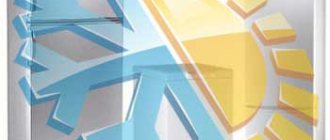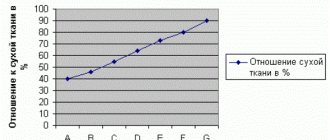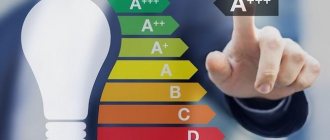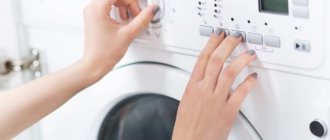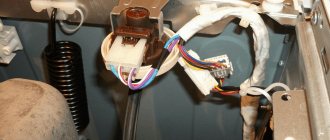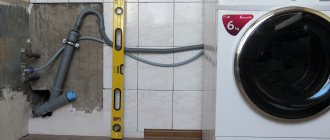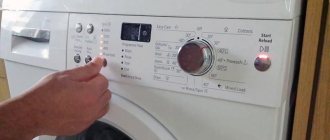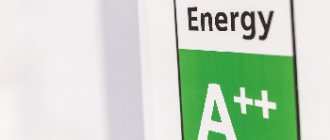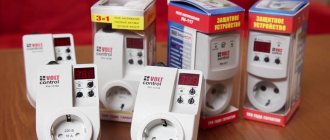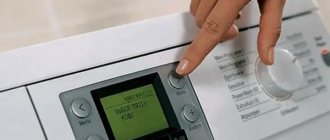Household appliances / Washing machines / How to choose a washing machine
For some time now, information about the level of energy efficiency of household appliances has been an integral part of the equipment parameters presented on the label. The main energy consumption classes of washing machines: A, B, C, D, E, F, G. Over time, the efficiency of electrical equipment has increased, but the scale has remained unchanged. As a result, a new designation for the most economical devices appeared: the same letter A, but with the addition of one or more pluses (A+, A++).
What is the electricity consumption class?
The higher the class, the more efficiently the device uses the energy consumed, but because of this it is also more expensive. This parameter is one of the main indicators of the quality of household appliances. If you are looking for an economical washing machine, be sure to look at its energy efficiency rating. To make the choice easier for consumers, experts have developed a seven-point letter classification system for washing machines, which can be used to evaluate:
- quality of washing;
- spin quality;
- level of power consumption.
Until 2010, the classification from A to G was adopted, later a new scale began to be used - from A+++ to D. The methodology for establishing energy efficiency was also changed. To determine, compare the consumption of water and electricity under different conditions:
- when fully loaded;
- with incomplete loading;
- at different water temperatures throughout the year - on average 220 cycles are taken into account.
To make it easier for consumers to navigate the numbers, manufacturers came up with a classification of SMA based on energy efficiency. A multi-colored sticker is glued to the front panels of the equipment. Thanks to the pictures, the information is understandable to a native speaker of any language. The energy efficiency gradation is shown in different colors.
Basic Concepts
Using this parameter, it has become possible to indicate the quality of most household appliances. For this purpose, a special seven-point classification system for washing machines was specially developed depending on the quality of washing, the level of energy consumption and the quality of spinning clean laundry.
Most often in stores you can find household laundry appliances labeled A and B, which correspond to an excellent and very good level of energy savings in the classification system used. It is almost impossible to find the letters F and G on household appliances sold in stores - their quality can be described as poor and very poor.
It is very rare to find devices of normal quality level D and satisfactory quality E. The letter is usually indicated on a sticker located on the body.
In order for a device to be assigned a certain level of quality for each of the three classification parameters, a series of tests are carried out, during which the performance of the tested model is compared with a reference device.
In this video, they will tell you what energy consumption classes apply to household appliances, in particular for washing machines.
The reference device is not an ordinary washing machine, but an installation specially created for these purposes, which only vaguely resembles a device familiar to everyone. Its main distinguishing feature is the constancy of all performance indicators and mode every time it is started.
This is precisely what allows us to conduct a comparative report of the indicators of the studied equipment samples. With the indicators that determine the washing and spin classes, everything should be extremely clear.
In the first case, special reference patches with contaminants are used, which are compared after a test wash. Based on the washing results, the tested model is assigned a specific letter symbol indicating the quality of the wash.
The main indicator of washing quality is its efficiency index. For example, to characterize the quality of the spin cycle, the percentage of moisture in the laundry is analyzed after the end of the test wash. The lower its indicators, the better the quality of the wash performed.
Why, during the test, the reference machine and the machine under study are started in the same washing modes, and the moisture content of the laundry from the machine being tested is assessed in relation to the reference indicators. Based on the test results, the washing machine is assigned a certain level of quality for spinning clothes.
Energy class is a much more complex indicator. Initially, a scale with grades from A to G was also used to characterize this indicator, but since progress inexorably moves forward, in 2002 another type of energy consumption A+ was added, which is still considered the best indicator.
Household appliances that meet this parameter are characterized by an electricity consumption of less than 0.17 kW/kg, which makes this type of household appliance more economical.
Energy classes
To calculate the energy consumption indicator, as well as for other indicators of the adopted classification system, a comparison of indicators with the indicators of a reference washing machine under the same washing conditions is used.
These conditions are taken to be a temperature of plus 60 degrees and a washing time of one hour. Only 1 kg cotton fabric is used as loading.
The total electrical energy expended during the test wash is taken as an indicator of the energy consumption of the tested model.
After the test is completed, the performance of the tested model is compared with the reference ones, after which the device is assigned the appropriate type of energy consumption. The lowest energy consumption corresponds to class A+.
The next parameter of energy consumption was considered the best 10 years ago - class A is characterized by low energy consumption, only from 0.17 to 0.19 kWh/kg. Economical energy consumption is considered to be energy consumption of 0.19-0.23 and 0.23-0.27, inherent in consumption classes B and C, respectively.
Medium and high consumption are inherent in products marked with the symbols D and E, for which the electricity consumption values are 0.27-0.31 and 0.31-0.35 kWh/kg.
There are practically no devices on sale anymore with an energy consumption of 0.35-0.39 or more than 0.39, which correspond to classes F and G, but they are still present in the general classification.
How to determine the energy consumption class?
The problem is solved by relating actual and reference costs. Different models, having equal energy consumption, may belong to different energy consumption groups. It depends on how rationally they use water and how many revolutions they produce. That is why, when choosing an automatic washing machine (AWA), you need to look at all the characteristics in a comprehensive manner. Each device has a sticker informing the consumer about:
- energy efficiency;
- brand and model;
- annual energy consumption, kWh;
- annual water costs, l;
- spin and drying class A-G;
- maximum load, kg;
- noise, dB.
Today, the majority of SMAs offered on the market have energy consumption class A or B. If the equipment is marked with the letters F or G, it does not deserve attention - its quality can be characterized as bad and very bad, respectively. Devices with energy consumption classes D and E - normal and satisfactory - are rarely found on the market. Before assigning energy saving classes to SMA for each parameter - washing, spinning, energy efficiency - a comparison is made with the standard.
Energy class
This indicator is determined for all electrical household appliances according to European standards. A certain level of energy consumption corresponds to its own class. Energy consumption classes of washing machines are designated by English letters from A to G. The highest level of energy consumption is G, A is the most economical equipment.
Currently, the bar has been raised, and washing machines with energy consumption classes A+, A++, A+++ have appeared. There are no limits to the advantages, but practice shows that this is not always a plus for the budget. It is important not to forget that for a constantly running refrigerator, energy consumption class A++ is a big savings. The same A++ energy consumption class for a washing machine that works only a couple of hours a week will not fill the budget much. But the cost of the machine itself is much higher than that of its energy-saving brother. To choose the right washing machine, you need to take this nuance into account.
What is the standard?
The standard for assessing the capabilities of equipment is not a simple SMA, but a special installation with stable performance indicators. The device under study is compared with the reference one. To evaluate the washing ability of the model, special reference rags are washed. To estimate energy consumption, find out how much electrical energy is consumed during a test wash. Tests are carried out at a temperature of 60 °C. Loading: 1 kg of cotton fabric.
Based on the test results, the obtained indicators are compared with the reference ones, and the SMA is assigned the appropriate group. The energy consumption table allows you to determine how much energy the device spends in 1 hour when loading 1 kg of cotton fabric. To find out the energy costs when the drum is loaded, you need to multiply the corresponding power consumption (it is indicated in the energy consumption table) by the weight of the laundry.
| Consumption class | Power consumption, kW/h per kg |
| A (A+++, A++, A+) | 0,13-0,17 |
| IN | 0,17-0,19 |
| WITH | 0,23-0,27 |
| D | 0,27-0,31 |
| E | 0,31-0,35 |
| F | 0,35-0,39 |
| G | more than 0.39 |
What are classes for and how to define them
The power of any device can be determined by the number of specified watts. But it can be difficult for an ordinary user to navigate the numbers. Therefore, manufacturers have simplified the task by creating classes of electricity consumption. Considering the amount of energy consumed, the washing machine is designated by a Latin letter. The energy consumption table below shows the class, as well as how much energy the machine will consume in one hour when loading one kilogram of things.
| Marking | Meaning |
| SMA with energy consumption class A++ is the most economical among all machines today. | To wash 1 kg of laundry, the machine will consume only 0.15 kW/h. |
| Class A+ is considered less economical . | If you choose this washing machine, it will process a kilogram of laundry using less than 0.17 kWh. |
| Machines marked class A. | In this case, a little more resources are consumed - 0.17-0.19 kW per hour per kilogram of things. |
| Energy class B. | The consumption of such a SM ranges from 0.19 to 0.23 kW per hour. |
| efficiency class C. | To process one kilogram of laundry per hour, 0.23-0.27 kW will be required. |
| Washing machine with energy class D. | Energy consumption will be 0.27-0.31 kW/h. |
| Washing machines marked E. | Normal consumption will be 0.31-0.35 kW per hour. |
| Class F. _ | When washing a kilogram of clothes, 0.35-0.39 kW will be used per hour. |
| " wasteful" car with class G. | The consumption will be more than 0.39 kW per hour. |
It is important to know! Testing to determine energy saving classes was carried out under special conditions. The readings may increase depending on the selected mode.
How did the classification of energy consumption come about?
Even 20 years ago, buyers began to pay attention to how economical the machine was to operate, and not just to the set of functional qualities. Even then, cars began to display information about energy efficiency. However, indications differed in different countries. Therefore, in 1992, a single classification with Latin letters was officially created in the EU. Now it is used all over the world, marking the body of the washing machine with special stickers.
How to choose?
The reference wash performance is not the only criterion for energy consumption. SMA modifications are distinguished by optimization of the programmable mode. For example, if you need to wash heavily soiled clothes, a machine with energy efficiency group C will spend 2.4 hours. And its more economical competitors from group A will wash the same thing in just 2 hours. Thanks to this, savings are achieved: better means faster. The less time the machine spends on washing, the less electricity it costs.
Manufacturers are constantly improving technology, equipment is becoming more and more efficient. If before 2010 there was only efficiency A, today it is divided into A+, A++ and A+++ - SMAs with such icons consume 10, 30 and 50% less, respectively.
Energy-efficient washing machines are more expensive - is it worth the overpayment? Considering their service life, it’s worth it. Budget versions last at least 5 years, good ones - 15-20 years. During this time, you can save a lot of energy.
What affects power consumption?
- Mode. The longer the wash cycle and the hotter the water, the higher the energy consumption.
- Loading. The more laundry the SMA washes, the more energy it uses.
- Life time. As it is used, scale deposits on the heating element - the efficiency of the heating element decreases, it cannot heat water as efficiently as before. Electricity costs are rising. To prevent overconsumption and preserve the heating element, use descaling agents in a timely manner.
It is difficult to accurately calculate costs, and it is not necessary - the main thing is to choose an economical machine.
Model overview
To ensure your SMA uses electricity economically, pay attention to its efficiency. Let's see what the market offers and how washing machines belonging to the middle price category have proven themselves.
The following are the most rated models in their groups.
Electrolux EWW 51476 WD - “B”
Modification with drying - up to 4 kg. There are 3 drying programs. Touch control. Backlit display. Direct drive - the device operates quietly. The body is white. Timer - up to 20 hours. 49/75 dB - noise level. There is a compartment for liquid powder.
Specifications:
| Energy consumption, kW*h/kg | 0,14 |
| Maximum load, kg | 7 |
| Spin speed rpm | 1400 |
| type of instalation | freestanding |
| Load Type | frontal |
| Tank material | plastic |
| Energy class | IN |
| Washing class | A |
| Spin efficiency class | IN |
| Water consumption, l | 52 |
| Number of programs | 10 |
| Dimensions, (WxDxH), cm | 60x52x85 |
| Weight, kg | 68,4 |
| Cost, rubles | 42 000 |
| Drying | No |
Users praised:
- quiet operation;
- good drying;
- simple controls.
Noticed disadvantages:
- vibrates a little during the spin cycle;
- small load if wash and dry;
- Ineffective steam function.
There are many complaints about breakdowns - electric shocks, the pump, heating element, etc. break. The main advantage of this model is dry laundry at the exit. It is because of this function that it belongs to group “B”. Drying clothes on a line or sacrificing energy costs - everyone decides for themselves.
Indesit IWUB 4085 - “A”
A narrow white model with a removable lid - can be built under the sink or into furniture. Intelligent control. Delay timer - up to 12 hours. Noise during washing/spin - 59/76 dB. The hatch diameter is 30 cm.
| Energy consumption, kW*h/kg | 0,15 |
| Maximum load, kg | 4 |
| Spin speed rpm | 800 |
| type of instalation | freestanding |
| Load Type | frontal |
| Tank material | plastic |
| Energy class | A |
| Washing class | A |
| Spin efficiency class | D |
| Water consumption, l | 39 |
| Number of programs | 13 |
| Dimensions, (WxDxH), cm | 60x33x85 |
| Weight, kg | 66 |
| Cost, rubles | 10 800 |
| Drying | No |
Benefits according to users:
- Many useful programs;
- Compact - shallow depth;
- Easy to operate;
- Affordable price;
- Express mode for 15 minutes;
- Shoe mode;
- Repairable.
Flaws:
- There is no express mode in hot water;
- Vibrates during the spin cycle;
- Poorly distributes things during the spin cycle;
- It takes a long time to wash and consumes a lot of electricity.
The main complaints about this model stem from its relatively low energy efficiency - long washing times, high energy consumption.
Samsung WF8590NLW9 - “A+”
There is a removable cover for installation. With intelligent control. White body. Noise - 60/74 dB. Ceramic heater.
| Energy consumption, kW*h/kg | 0,17 |
| Maximum load, kg | 6 |
| Spin speed rpm | 1000 |
| type of instalation | freestanding |
| Load Type | frontal |
| Tank material | plastic |
| Energy class | A+ |
| Washing class | A |
| Spin efficiency class | WITH |
| Water consumption, l | 48 |
| Number of programs | 8 |
| Dimensions, (WxDxH), cm | 60x45x85 |
| Weight, kg | 53 |
| Cost, rubles | 15 700 |
| Drying | No |
This model is praised for its ease of operation and trouble-free operation. Samsung products, as always, are at their best - the Koreans, introducing their own energy-saving technologies, produce some of the most economical models. Users noted with approval the following points:
- Auto-weighing;
- Adjustment of temperature and speed;
- No vibrations.
Owners especially like the flexibility of settings - if you don’t have the right program, you can select the basic functions yourself. The disadvantages are that it is difficult to reach the filter, short hoses, and only partial protection against leaks.
LG F-1296TD4 - “A++”
With removable cover for installation. Silver body. Delayed start timer - 19 hours. Noise level - 54/65 dB.
| Energy consumption, kW*h/kg | 0,17 |
| Maximum load, kg | 8 |
| Spin speed rpm | 1000 |
| type of instalation | freestanding |
| Load Type | frontal |
| Tank material | plastic |
| Energy class | A++ |
| Washing class | A |
| Spin efficiency class | IN |
| Water consumption, l | 56 |
| Number of programs | 13 |
| Dimensions, (WxDxH), cm | 60x55x85 |
| Weight, kg | 62 |
| Cost, rubles | 24 600 |
| Drying | No |
Users like this machine for its spaciousness, stylish design, economical water consumption, uniform distribution of laundry, silent operation and the ability to wash large items. The disadvantage noted is rather subjective - it is an irritating signal. Also a disadvantage is the lack of memory, which does not allow you to save custom programs.
